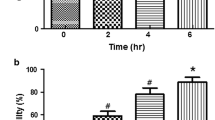Abstract
Lithium preparations are commonly used drug in treating mental disorders and bipolar diseases, but metal’s cytotoxic mechanisms have not yet been completely understood. In this study, we investigated the cytotoxic mechanisms of lithium in freshly isolated rat hepatocytes. Lithium cytotoxicity were associated with reactive oxygen species (ROS) formation and collapse of mitochondrial membrane potential and cytochrome c release into the hepatocyte cytosol. All of the mentioned lithium-induced cytotoxicity markers were significantly (P < 0.05) prevented by ROS scavengers, antioxidants, mitochondrial permeability transition pore sealing agents and adenosine triphosphate generators. Hepatocyte glutathione (GSH) was also rapidly oxidized and GSH-depleted hepatocytes were more resistant to lithium-induced oxidative stress markers. This suggests that lithium is activated by GSH. Our results also showed that CYP2E1 is involved in lithium oxidative stress mechanism. Lithium cytotoxicity was also associated with mitochondrial injuries initiated by increased ROS formation resulted from metal-CYP2E1 destructive interaction or metal-induced disruption of mitochondrial electron transfer chain. Methyl donors such as betaine, methionine, or folic acid prevented lithium cytotoxicity, and this suggests that this metal is detoxified by phase II metabolic methylation. In conclusion lithium-induced cytotoxicity could be attributed to oxidative stress and mitochondrial dysfunction.



Similar content being viewed by others
References
Ahmad M, Elnakady Y, Farooq M, Wadaan M (2011) Lithium induced toxicity in rats: blood serum chemistry, antioxidative enzymes in red blood cells and histopathological studies. Biol Pharm Bull 34(2):272–277
Al Banchaabouchi M, Pena de Ortiz S, Menendez R, Ren K, Maldonaldo-Vlaar CS (2004) Chronic lithium decreases Nurr1 expression in the rat brain and impairs spatial discrimination. Pharmacol Biochem Behav 79:607–621
Andersson BS, Aw TY, Jones DP (1987) Mitochondrial transmembrane potential and pH gradient during anoxia. Am J Physiol 252:349–355
Aniya VL, Matsusaki K (1983) Effects of neutral salts on microsomal drug metabolizing enzyme system in rats. Jpn J Pharmacol 33:647–653
Blake LD, Lucas DN, Aziz K, Castello-Cortes A, Robinson PN (2008) Lithium toxicity and the parturient: case report and literature review. Int J Obstet Anesth 17:164–169
Boelsterli UA (2007) Xenobiotic-induced oxidative stress: cell injury, signaling, and gene regulation. In: Boelsterli UA (ed) Mechanistic toxicology: the molecular basis of how chemicals disrupt biological targets, 2nd edn. CRC Press, Boca Raton, pp 117–175
Chadha VD, Bhalla P, Dhawan DK (2008) Zinc modulates lithium-induced hepatotoxicity in rats. Liver Int 28(4):558–565
Chirino YI, Pedraza-Chaverri J (2009) Role of oxidative and nitrosative stress in cisplatin-induced nephrotoxicity. Exp Toxicol Pathol 61:223–242
Chiu CT, Chuang DM (2010) Molecular actions and therapeutic potential of lithium in preclinical and clinical studies of CNS disorders. Pharmacol Ther 128:281–304
Ciriolo MR, Desideri A, Paci M, Rotilio G (1990) Reconstitution of Cu, Zn superoxide dismutase by the Cu(I)–glutathione complex. J Biol Chem 265:11030–11034
Dunner DL (2000) Optimizing lithium treatment. J Clin Psychiatry 61(9):76–81
Eskandari MR, Pourahmad J, Daraei B (2011) Thallium (I) and thallium (III) induce apoptosis in isolated rat hepatocytes by alterations in mitochondrial function and generation of ROS. Toxicol Environ Chem 93:145–156
Galati G, Teng S, Moridani MY, Chan TS, O’Brien PJ (2000) Cancer chemoprevention and apoptosis mechanisms induced by dietary polyphenolics. Drug Metabol Drug Interact 17:311–349
Gogvadze V, Orrenius S, Zhivotovsky B (2006) Multiple pathways of cytochrome c release from mitochondria in apoptosis. Biochimica et Biophysica Acta 1757:639–647
Grimm S, Brdiczka D (2007) The permeability transitions pore in cell death. Apoptosis 12:841–855
Halliwell B (2006) Reactive species and antioxidants. Redox biology is a fundamental theme of aerobic life. Plant Physiol 141:312–322
Hissin J, Hilf R (1976) A fluorometric method for determination of oxidised and reduced glutathione in tissues. Anal Biochem 74:214–226
Hunt GE, Beilharz GR, Stolier LH (1983) The effect of lithium on rat erythrocyte choline, glycine and glutathione levels. Biochem Pharmacol 32:2981–2983
Jefferson JW (2010) A clinician’s guide to monitoring kidney function in lithium-treated patients. J Clin Psychiatry 71:1153–1157
Kappus H, Sies H (1981) Toxic drug effects associated with oxygen metabolism: redox cycling and lipid peroxidation. Experientia 37:1233–1241
Khan S, O’Brien PJ (1991) 1-Bromoalkanes as new potent nontoxic glutathione depletors in isolated rat hepatocytes. Biochem Biophys Res Commun 179:436–441
Kiełczykowska M, Musik I, Pasternak K (2008) Relationships between silicon content and glutathione peroxidase activity in tissues of rats receiving lithium in drinking water. Biometals 21:53–59
Lithium. British National Formulary (2006). http://www.bnf.org/bnf/bnf/current/29546.htm
Malhotra A, Dhawan DK (2008) Zinc improves antioxidative enzymes in red blood cells and hematology in lithium-treated rats. Nutr Res 28(1):43–50
Paolicchi A, Minotti G, Tonarelli P, Tongiani R, De Cesare D, Mezzetti A, Dominici S, Comporti M, Pompella A (1999) γ-Glutamyl transpeptidase-dependent iron reduction and low density lipoprotein oxidation: a potential mechanism in atherosclerosis. J Investig Med 47:151–160
Pompella A, Visvikis A, Paolicchi A, De Tata V, Casini AF (2003) The changing faces of glutathione, a cellular protagonist. Biochem Pharmacol 66:1499–1503
Pourahmad J, O’Brien PJ (2000) A comparison of hepatocyte cytotoxic mechanisms for Cu2+ and Cd2+. Toxicology 143:263–273
Pourahmad J, O’Brien PJ (2001) Biological reactive intermediates that mediate chromium (VI) toxicity. Adv Exp Med Biol 500:203–207
Pourahmad J, Rabiei M, Jokar F, O’Brien PJ (2005) A comparison of hepatocyte cytotoxic mechanisms for chromate and arsenite. Toxicology 206(3):449–460
Pourahmad J, Ghashang M, Ettehadi H, Ghalandari A (2006) A search for cellular and molecular mechanisms involved in depleted uranium toxicity. Environ Toxicol 21(4):349–354
Pourahmad J, Eskandari MR, Daraei B (2010a) A comparison of hepatocyte cytotoxic mechanisms for thallium (I) and thallium (III). Environ Toxicol 25(5):456–467
Pourahmad J, Eskandari, Shakibaei R, Kamalinejad M (2010b) A search for hepatoprotective activity of fruit extract of Mangifera indica L. against oxidative stress cytotoxicity. Plant Foods Hum Nutr 65(1):83–89
Pourahmad J, Eskandari MR, Nosrati M, Kobarfard F, Khajeamiri AR (2010c) Involvement of mitochondrial/lysosomal toxic cross-talk in ecstasy induced liver toxicity under hyperthermic condition. Eur J Pharmacol 643:162–169
Pourahmad J, Hosseini MJ, Eskandari MR, Shekarabi SM, Daraei B (2010d) Mitochondrial/lysosomal toxic cross-talk plays a key role in cisplatin nephrotoxicity. Xenobiotica 40:763–771
Riadh N, Allagui MS, Bourogaa E, Vincent C, Croute F, Elfeki A (2011) Neuroprotective and neurotrophic effects of long term lithium treatment in mouse brain. Biometals 24:747–757
Shaldubina A, Agam G, Belmaker RH (2001) The mechanism of lithium action: state of the art, ten years later. Prog Neuropsychopharmacol Biol Psychiatry 25:855–866
Shao L, Cui J, Young LT, Wang JF (2008) The effect of mood stabilizer lithium on expression and activity of glutathione s-transferase isoenzymes. Neuroscience 151(2):518–524
Spear N, Aust SD (1994) Thiol-mediated NTA-Fe(III) reduction and lipid peroxidation. Arch Biochem Biophys 312:198–202
Tajes M, Gutierrez-Cuesta J, Folch J, Ferrer I, Caballero B, Smith MA et al (2008) Lithium treatment decreases activities of kinases in a murine model of senescence. J Neuropathol Exp Neurol 67:12–13
Tandon A, Nagpaul JP, Dhawan D (1997) Effect of lithium on the hepatic drug metabolizing enzymes of protein deficient rats. Biol Trace Elem Res 59:1–7
Tandon A, Dhawan DK, Nagpaul JP (1998) Effect of lithium on hepatic lipid peroxidation and antioxidative enzymes under different dietary protein regimens. J Appl Toxicol 18:87–90
Tandon A, Nagpal JP, Bandhu HK, Singh NB, Dhawan D (1999) Effect of lithium on hepatic and serum elemental status under different dietary protein regimens. Biol Trace Elem Res 68:51–62
Tien M, Bucher JR, Aust SD (1982) Thiol-dependent lipid peroxidation. Biochem Biophys Res Commun 107:279–285
Valko M, Leibfritz D, Moncol J, Cronin MT, Mazur M, Telser J (2007) Free radicals and antioxidants in normal physiological functions and human disease. Int J Biochem Cell Biol 39:44–84
Author information
Authors and Affiliations
Corresponding author
Rights and permissions
About this article
Cite this article
Eskandari, M.R., Fard, J.K., Hosseini, MJ. et al. Glutathione mediated reductive activation and mitochondrial dysfunction play key roles in lithium induced oxidative stress and cytotoxicity in liver. Biometals 25, 863–873 (2012). https://doi.org/10.1007/s10534-012-9552-8
Received:
Accepted:
Published:
Issue Date:
DOI: https://doi.org/10.1007/s10534-012-9552-8




